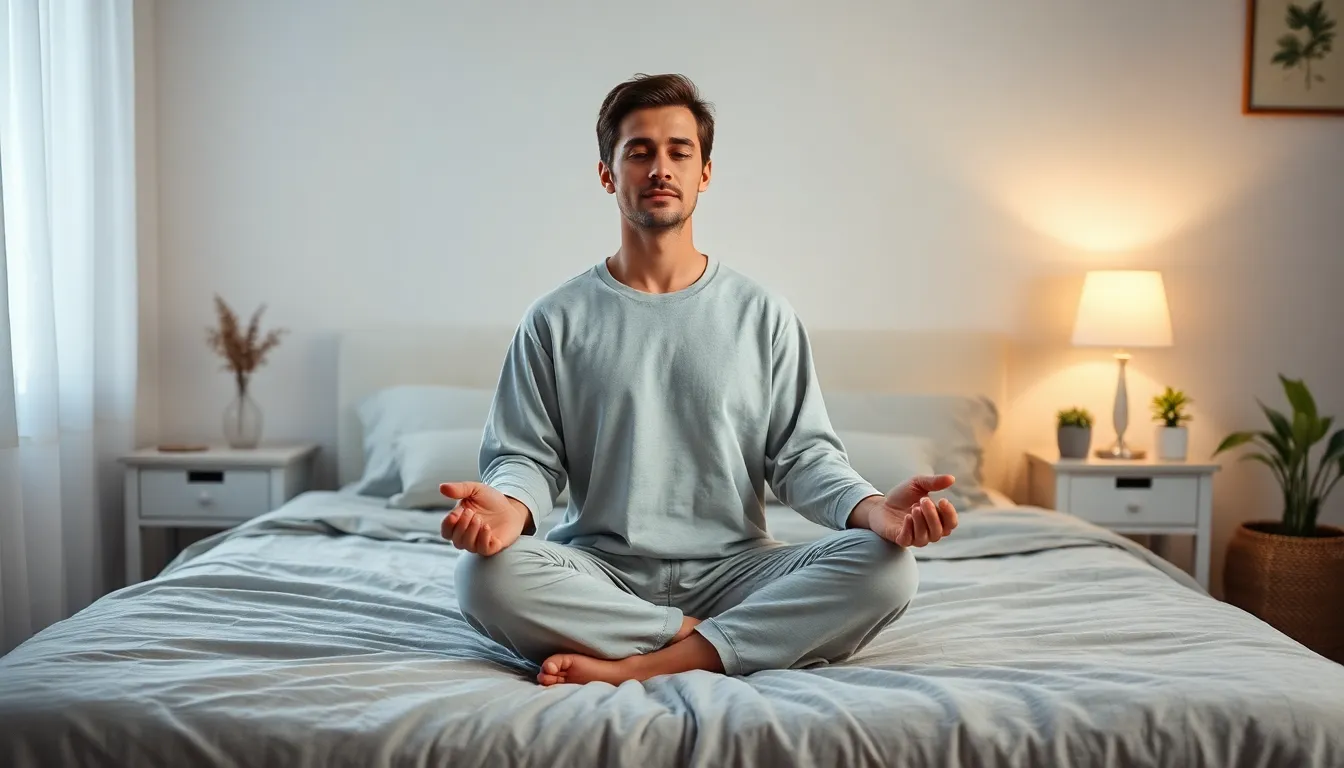In today’s fast-paced world, a good night’s sleep often feels like a luxury. Yet, establishing a pre-sleep routine can be the key to unlocking restful slumber. By creating a calming ritual before bed, individuals can signal their bodies that it’s time to wind down and prepare for restorative sleep.
From dimming the lights to engaging in relaxing activities, a well-crafted pre-sleep routine not only enhances sleep quality but also promotes overall well-being. Whether it’s reading a book or practicing mindfulness, these small changes can lead to significant improvements in sleep patterns. Discovering the right routine can transform bedtime from a struggle into a peaceful escape.
Table of Contents
ToggleWhat Is a Pre-Sleep Routine?
A pre-sleep routine consists of intentional activities performed before bedtime that promote relaxation and signal the body to prepare for sleep. This routine typically includes practices such as dimming lights, reducing screen time, and engaging in calming activities like reading or meditation. By following a consistent pre-sleep routine, individuals can enhance their sleep quality and improve overall well-being.
Key elements of a pre-sleep routine may include:
- Dimming lights: Lowering light levels helps signal the body that it’s time to wind down.
- Limiting screen time: Reducing exposure to screens at least 30 minutes before sleep can decrease blue light exposure, which interferes with melatonin production.
- Engaging in relaxation techniques: Activities such as deep breathing, yoga, or meditation help calm the mind and prepare the body for rest.
- Reading a book: Choosing a physical book instead of an e-reader helps minimize screen time and enhance focus on relaxing content.
Implementing these elements can lead to a more effective pre-sleep routine, fostering a smoother transition into restorative sleep.
Benefits of a Pre-Sleep Routine

Establishing a pre-sleep routine offers numerous advantages that enhance overall well-being. Two primary benefits include improved sleep quality and better mental health.
Improved Sleep Quality
Improved sleep quality results from consistent pre-sleep practices. A calming routine helps lower cortisol levels, reducing stress. Furthermore, relaxing activities promote deeper sleep cycles, making it easier to fall asleep and stay asleep. Research shows that individuals who engage in routines report 30% better sleep quality than those who don’t. Incorporating elements like dim lighting and soothing sounds increases melatonin production, further supporting restorative sleep.
Better Mental Health
Better mental health stems from promoting relaxation before sleep. A pre-sleep routine can lower anxiety levels, leading to a clearer mind. Engaging in mindfulness or gentle stretching enhances mood, contributing to emotional stability. Studies indicate that sleep disruptions significantly correlate with depression symptoms. By fostering better sleep, individuals can experience a 20% decrease in mood-related issues. Effective pre-sleep rituals nurture psychological resilience, making it easier to cope with daily stressors.
Components of an Effective Pre-Sleep Routine
An effective pre-sleep routine combines several components that work together to prepare the body for quality sleep. Implementing relaxation techniques, limiting screen time, and creating an ideal sleep environment plays a crucial role in enhancing sleep quality.
Relaxation Techniques
Relaxation techniques help calm the mind and body before bedtime. Practices such as deep breathing, progressive muscle relaxation, and mindfulness meditation effectively reduce stress and promote a sense of tranquility. Yoga stretches can also alleviate physical tension, making it easier to transition into sleep. Engaging in these activities for 10-30 minutes each evening signals the body to unwind, transforming the pre-sleep experience into a peaceful ritual.
Limiting Screen Time
Limiting screen time is essential in establishing a successful pre-sleep routine. Exposure to blue light from devices like smartphones, tablets, and televisions can disrupt melatonin production, making falling asleep more challenging. Reducing screen usage at least one hour before bed creates an opportunity for the mind to relax. Instead, individuals might choose to read a physical book, take a warm bath, or engage in other low-stimulation activities that promote relaxation.
Ideal Sleep Environment
Creating an ideal sleep environment is vital for fostering restorative rest. Key elements include a comfortable mattress, appropriate pillow support, and optimal room temperature, typically around 60-67°F (15-19°C). Dimming the lights and using blackout curtains can also contribute to a sleep-friendly atmosphere. Additionally, minimizing noise and ensuring proper ventilation enhance comfort, making it easier for the body to transition into deep sleep.
Tips for Creating Your Own Pre-Sleep Routine
Creating a personalized pre-sleep routine enhances relaxation and signals the body that it’s time to wind down. Individuals can explore various activities to tailor their rituals effectively.
Personalizing Your Routine
Personalizing a pre-sleep routine involves selecting activities that resonate with an individual’s preferences and lifestyle.
- Choose Relaxing Activities: Engage in calming activities, such as reading, journaling, or listening to soothing music.
- Set a Wind-Down Period: Establish a specific time frame for winding down, ideally 30 to 60 minutes before bedtime.
- Incorporate Mindfulness: Include mindfulness practices like meditation or gratitude exercises, which help calm the mind and foster relaxation.
- Adjust Lighting: Dimming lights or using soft, warm lighting can create a tranquil atmosphere conducive to sleep.
Sticking to Consistency
Consistency is vital for an effective pre-sleep routine.
- Establish a Regular Schedule: Go to bed and wake up at the same time each day, even on weekends, to regulate the body’s internal clock.
- Follow a Structured Sequence: Maintain a consistent order of activities to signal the body when to unwind and prepare for sleep.
- Avoid Major Changes: Make gradual adjustments to the routine, allowing time for the body to adapt without significant disruptions.
- Track Progress: Utilize a sleep diary or app to monitor sleep patterns and make necessary tweaks to optimize the routine.
Establishing a pre-sleep routine can significantly enhance sleep quality and overall well-being. By incorporating calming activities and creating a tranquil environment, individuals can effectively signal their bodies to relax and prepare for restorative sleep. The benefits extend beyond just better sleep; improved mental health and emotional stability are also key outcomes.
Consistency in these practices is essential for lasting results. As individuals personalize their routines and commit to a structured wind-down period, they’ll likely find that their bedtime transforms from a source of stress into a peaceful ritual. Embracing these small yet impactful changes can lead to a more restful night and a brighter day ahead.



